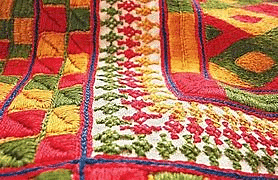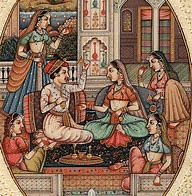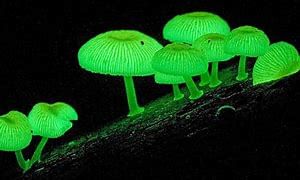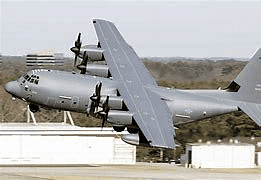UPSC Daily Current Affairs- 19th November 2023 | Current Affairs & Hindu Analysis: Daily, Weekly & Monthly PDF Download
GS-I
Tamil Lambadi embroidery
Subject: Art and Culture

Why in News?
Recently, The Porgai Artisan Association Society have been trying to keep the intriguing Tamil Lambadi art of embroidery alive.
Background:-
- The Porgai Artisan Association Society, with 60 plus women, has been making and selling embroidered clothes to ensure that there is awareness about the art form and that it is passed on to the next generation.
About Tamil Lambadi embroidery:-
- Origin: Hailing from Tamil Nadu, this craft is deeply rooted in the cultural practices and traditions of the Lambadi community.
- Historical Migration:
- Centuries ago, the Lambadi tribals, originally from North Western India, migrated to the South in search of livelihood.
- Despite their nomadic roots, they eventually settled in regions such as Madhya Pradesh, Maharashtra, Karnataka, Andhra Pradesh, and Tamil Nadu.
- Settlement in Tamil Nadu:
- The Sittilingi Valley in Tamil Nadu marks the second southernmost settlement of Lambadis in India.
- Artistic Characteristics:
- Characterized by vibrant color schemes featuring bold and contrasting hues.
- Noteworthy for intricate embroidery and mirror work adorning textiles and clothing.
- Designs incorporate symbolic representations of nature, folklore, and traditional beliefs.
- Traditional Tamil Lambadi embroidery primarily features geometrical patterns with squares, rectangles, and circles.
- Influenced by local elements such as forests, birds, fruits, and flowers.
- Sustainable Practices:
- A significant portion of products from Porgai, representing this craft, is crafted from organic cotton cultivated in their own villages.
Significance:-
- It reflects the rich cultural heritage and identity of the Lambadi community.
- It serves as a medium for storytelling and preserving cultural narratives.
Source: The Hindu
Brijinder Nath Goswamy’s Role in Indian Miniature Art
Subject: Art and Culture

Why in News?
Shri Brijinder Nath Goswamy, an Indian art historian and expert in miniature paintings, recently passed away.
About Brijender Nath Goswamy
- Expertise: Widely recognized for his proficiency in the realm of Indian miniature painting, specifically the Pahari and Rajput schools of art.
- Prolific Writer:
- Earned acclaim as a prolific author with numerous works, including books, research papers, and articles, focusing on Indian art.
- Notable publications include "The Spirit of Indian Painting: Close Encounters with 101 Great Works 1100-1900," "Wonders of a Golden Age: Painting at the Court of the Great Mughals," and "Pahari Masters: Court Painters of Northern India."
- Honors:
- Recognized for his contributions with the Padma Shri in 1980 and the Padma Bhushan in 2007.
Miniature Paintings
- About:
- Miniature painting is a traditional style of art that is very detailed, often referred to as painting or working “in miniature”.
- It is typically small in size, often no larger than a few inches in height and width (not more than 25 square inches).
- Artists use fine brushes made from animal hair and natural pigments, often mixed with binders like gum.
- Styles of miniature paintings:
- Different styles of miniature painting include Pala school, Mughal miniature art, Rajput style, Deccan miniature art etc.
- Pahari school: Pahari painting includes several distinct schools or styles, each associated with a particular region or court, such as Guler, Kangra, Chamba, Basohli, and Mandi.
- It is characterized by the romantic themes, with a focus on the divine love between Radha and Krishna.
- It shows influences from both Rajput and Mughal painting traditions, resulting in a unique blend of styles.
- Ragamala paintings, which represent different musical modes (ragas) through images, are considered a significant genre within Pahari art.
- Rajput school: It encompasses various regional schools, each associated with a specific Rajput kingdom, including Mewar, Marwar, Jaipur, Bundi, Kota, Kishangarh etc.
- It is known for its bold and intense use of colors, often depicting scenes of valor and heroic events.
- Rajput miniatures explore themes of love, both human and divine, with depictions of Radha and Krishna being a popular subject.
- Famous artists like Sahibdin and Manohar were associated with this school.
- Mughal Miniature Art: It emerged as a significant art form during the reign of Emperor Akbar (1556-1605) and reached its zenith during the reigns of Jahangir and Shah Jahan.
- It is known for their realistic and naturalistic portrayal of subjects. Emphasis was placed on capturing accurate depictions of people, animals, and landscapes.
- Prominent artists include Basawan, Daswanth, Abdul Hasan and Bishandas etc.
- Deccan style: It emerged as a result of the rich cultural exchange and artistic interactions between the Deccan sultanates and the Mughal Empire in North India.
- It features intricate floral motifs and geometric designs in the background, adding decorative richness.
- Adil Shahi dynasty in Bijapur produced notable Deccan miniature paintings, known for their use of vibrant colors and details.
Source: The Hindu
GS-II
Global Talent Competitiveness Index (GTCI), 2023
Subject: Polity and Governance

Why in News?
The Global Talent Competitiveness Index has seen India fall sharply from rank 83 ten years ago to rank 103 in its latest report out recently.
About Global Talent Competitiveness Index (GTCI):
- It measures how countries grow, attract, and retain talent.
- It is an annual benchmarking report published by the prestigious chain of business schools, INSEAD.
- It provides a unique resource for decision-makers to understand the global talent competitiveness picture and develop strategies to boost their economies.
- The index uses two sub-indices: input and output.
- The input measures regulatory and business environments, as well as steps being taken to foster talent and retain it.
- The output side evaluates the quality of talent.
- Highlights of GTCI 2023:
- The 10th edition of the report covers 134 countries around the world across all income groups.
- Singapore, Switzerland, and the United States are among the top three countries on the index.
- Denmark, the Netherlands, Finland, Norway, Australia, Sweden, and the United Kingdom make up the rest of the Top 10.
- India is ranked 103, the worst among that of the BRICS countries. China remains at the top of the BRICS group of countries at rank 40, Russia at 52, South Africa at 68 and Brazil at 69.
- Other countries ranking better than India are Rwanda, Paraguay, Tunisia, Namibia, Bolivia, Ghana, El Salvador, Gambia, Kenya, Morocco, and Eswatini.
- As per the report, other emerging countries have shown improvements on this index, with China, Indonesia, and Mexico being cited for special mention.
Source: The Hindu
GS-III
243th Corps of Engineers Day
Subject: Defence

Why in News?
Recently, the Indian Army celebrated the 243th Corps of Engineers Day.
Background:-
- Chief of the Army Staff Gen Manoj Pande has conveyed best wishes to all ranks, veterans and families of the Corps on the occasion.
About 243th Corps of Engineers Day:-
- Role: The Indian Army Corps of Engineers serves as a combat support arm.
- Functions:
- Provides support in combat engineering and undertakes the development of infrastructure for armed forces and other defense organizations.
- Ensures border connectivity and offers assistance to civil authorities during natural disasters.
- Four Pillars of the Corps:
- Encompasses four key components: Combat Engineers, Military Engineer Service, Border Road Organization, and Military Survey.
- Historical Background:
- Originally comprised three distinct groups: Madras Sappers, Bengal Sappers, and Bombay Sappers.
- These groups were merged into the Corps on the 18th of November 1932.
- Legacy:
- Since its establishment, the Corps of Engineers has a rich history marked by remarkable contributions in both wartime and peacetime.
Source: PIB
NISAR
Subject: Science and Technology

Why in News?
Recently, NASA, ISRO completed key tests ahead of NISAR’s launch early next year.
Background:-
- The mission, which has three-year duration, aims to survey all of Earth’s land and ice-covered surfaces every 12 days.
About NISAR:-
- Launch Year: The collaborative mission between NASA and ISRO, named the NASA-ISRO SAR (NISAR) Mission, is scheduled for launch in 2024.
- Mission Objectives:
- The NISAR Mission aims to measure changes in Earth’s ecosystems, dynamic surfaces, and ice masses, offering crucial data on biomass, natural hazards, sea level rise, and groundwater.
- It will support various applications beyond its primary objectives.
- Observation Details:
- NISAR will globally observe Earth's land and ice-covered surfaces at a regular interval of 12 days on ascending and descending passes, resulting in an average sampling rate of every 6 days throughout its baseline 3-year mission.
- NASA's Contribution:
- The National Aeronautics and Space Administration will supply one of the radars, a high-rate communication subsystem for science data, GPS receivers, and a payload data subsystem.
- Notably, NISAR will feature the largest reflector antenna ever launched by NASA.
- ISRO's Role:
- The Indian Space and Research Organisation will provide the spacecraft bus, the second radar (S-band radar), the launch vehicle, and associated launch services for NISAR.
Objectives:-
- Tracking subtle changes in the Earth’s surface,
- Spotting warning signs of imminent volcanic eruptions,
- Helping to monitor groundwater supplies, and
- Tracking the rate at which ice sheets are melting.
Significance:-
- NISAR’s data can help people worldwide better manage natural resources and hazards, as well as provide information for scientists to better understand the effects and pace of climate change.
Source: The Hindu
Mycena chlorophos
Subject: Environment and Ecology

Why in News?
Rare bioluminescent mushroom, Mycena chlorophos was spotted recently.
Background:-
- Decoding the Context: A team of researchers and the forest department have found a rare bioluminescent mushroom in the Kanyakumari Wildlife Sanctuary (KKWLS).
About Mycena chlorophos:-
- Mycena chlorophos is a species of agaric fungus in the family Mycenaceae.
- It was first described in 1860.
- The fungus is found in subtropical Asia, including India, Japan, Taiwan, Polynesia, Indonesia, Sri Lanka, Australia, and Brazil.
- In Japan, the mushroom is known as yakoh-take, or “night-light mushroom”.
- In the Bonin Islands, it is called “Green Pepe”.
- Cap is conical or flat.
- It is
- It is a bioluminescent fungus.
- There are around 103 species of bioluminescent fungi in the world, of which seven are found in India.
Source: Indian Express
C-130J Super Hercules
Subject: Defence

Why in News?
The Indian Air Force (IAF) successfully landed two of its C-130J-30 ‘Super Hercules’ military transport aircraft at a rudimentary and unfeasible airstrip in Uttarakhand.
About C-130J Super Hercules:
- It is a four-engine turboprop military transport aircraft.
- It is the latest production version of the C-130 Hercules. It replaced, in production, the previous C-130H.
- The C-130J Super Hercules made its first flight in 1996.
- It is the US Air Force’s principal tactical cargo and personnel transport aircraft.
- It was developed by Lockheed Martin, a US security and aerospace company.
- It primarily performs the tactical portion of the airlift mission, is capable of operating from rough, dirt strips, and is the prime transport for airdropping troops and equipment into hostile areas.
- The largest operators are the US Air Force, US Marine Corps, Australia, Canada, India, Italy, and the United Kingdom.
- Features:
- It has reduced crew requirements. A minimal crew of three men is required to operate this aircraft, including two pilots and one loadmaster.
- It has a payload capacity of 19 tonnes.
- It is powered by four Rolls-Royce AE 2100D3 turboprop engines.
- It has digital avionics, including a Head-Up Display (HUD) for each pilot.
- Range: 6,852 km (no payload)
- Speed: 644 km/hr
- Endurance: 20+ hours
- It is capable of short takeoffs and landings from unprepared runways.
- C-130J-30:
- It is a stretch version of the C-130J.
- The C-130J-30 adds 15 feet to the fuselage, increasing usable space (two more pallets of equipment) in the cargo compartment.
Source: Financial Express
|
38 videos|5283 docs|1116 tests
|





















